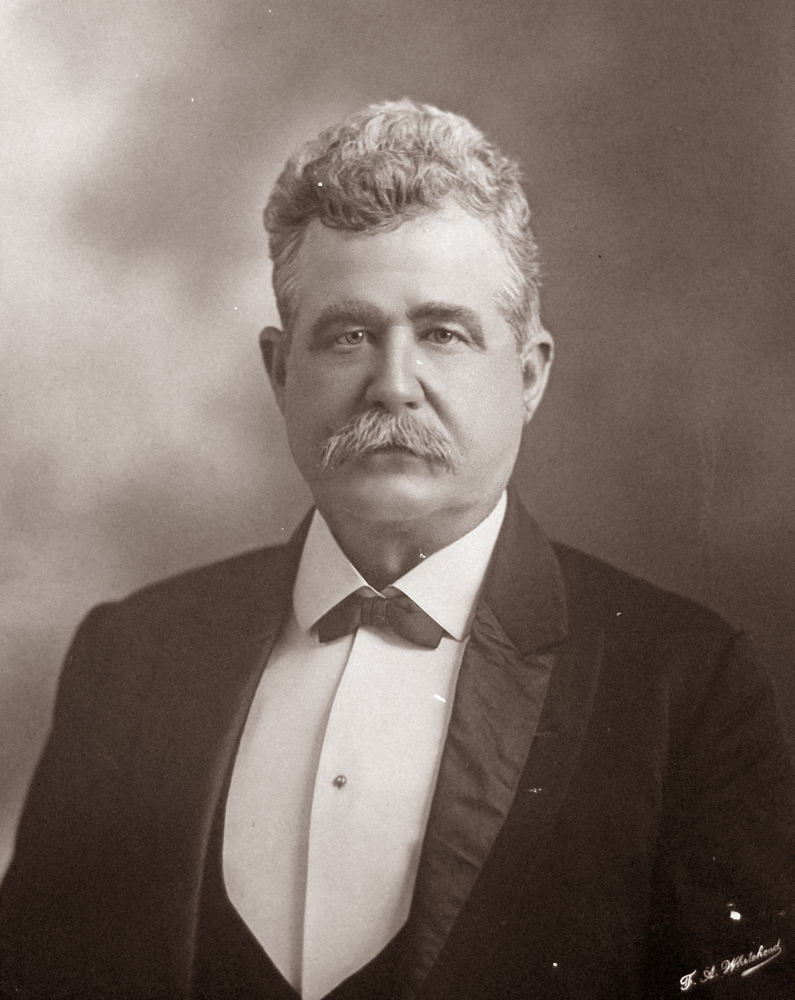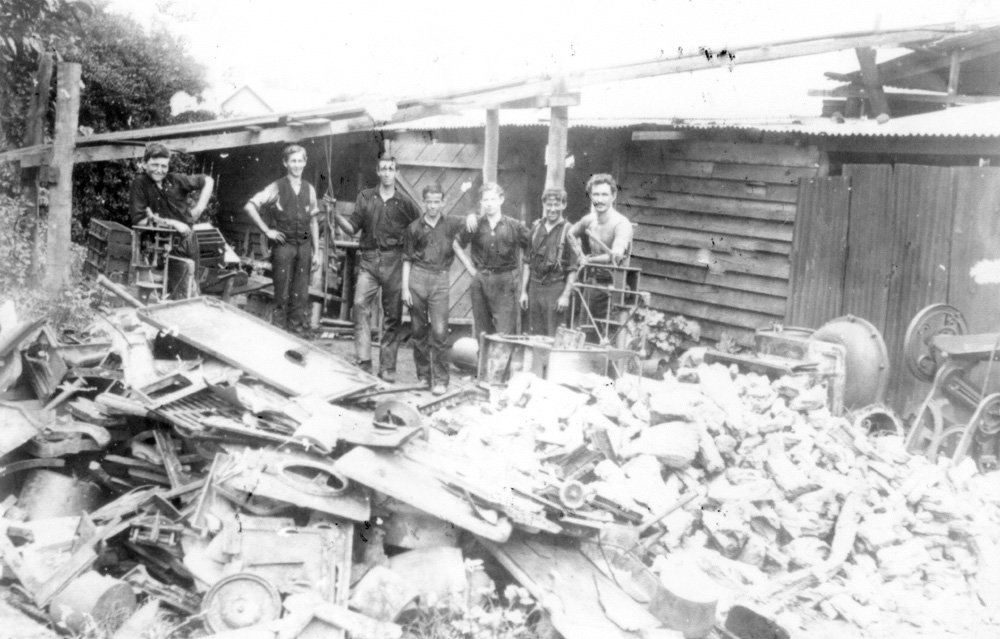Before Barbat’s foundry could make its mark on Ipswich, there was the small engineering firm of Mr Frederick Springall who was an Ipswich City Council alderman and later Mayor. About 1884 Springall entered a partnership with James Frost that lasted 10 years. Known as Springall & Frost they manufactured rolling stock and locomotives.1. The company entered history when it produced its first railway engine for the Queensland government and handed it over to the Minister for Railways at a ceremony here in Ipswich on Friday 11 October 1889. ‘Mrs Springall (then) broke a bottle of champagne on the cow catcher, and christened the engine “No. 1 Queensland”, amid ringing cheers.”2. This was a fine base to build on.
Shortly after this momentous occasion the proprietors floated the firm and by early 1890 it became known as Phoenix Engineering and Rolling Stock Company Ltd.3.
When Frost left the firm Mr Felix Barbat became the manager in 1895.4. Barbat was a southerner with engineering experience who saw the potential in Ipswich and chose to settle here. He lived on Denmark Hill with his wife and family of sons.5.
Felix Edward Barbat soon became a stalwart of industry in the town. He also became active in social and political circles and was viewed as a local leader. In 1928 an obituary painted him as ‘a large employer of labour, he was widely known in Queensland, and his ability as an engineer and his fine personality earned him a host of friends both in and out of the business world.’ 6.

Felix Edward Barbat, Ipswich, ca, 1920. – Image courtesy of Picture Ipswich
Phoenix Engineering was located at North Ipswich between The Terrace and Lowry Street and became somewhat of a landmark for the area. A public house called The White Swan had been located on this property in the 1860s.7. The business of the company was closely allied with that of the Railway Workshops so its proximity to them was an asset. Eventually they would have their own railway siding. Tendering for railway and other government contracts was part and parcel of the business, and these jobs became their bread and butter.
Shortly into the 20th century Phoenix began to experience financial problems8. which led to Messrs. F. E. Barbat and Co. becoming the new owners in October 1902. Felix was the principal of the new firm. With his considerable experience and as a sub-contractor in connection with the new railway workshops, he now also had the contract for the erection of the smithy to those works.9. He planned to extend the plant with the purchase and instalment of a British bolt and nut manufacturing machine that would be ‘on a scale sufficiently large to supply the requirements of the whole of the State.’ 10. With such great plans and several months work in hand, Barbats restarted the plant without delay and commenced operations with 40 personnel.11. Work progressed rapidly so that only six months later in April 1903 there were 100 employees at Barbats.12.
For the next few years Barbats continued to thrive under the direction of Felix. Contemporary projects include large castings for ‘the dome of the roof of the pump-house which is being built on the bank of the river in connection with the reticulation scheme for the new railway workshops.’13. This casting was of an unprecedented size for Ipswich and sufficiently significant to be reported on in the local newspaper.14. During the same year of 1903 Barbats also supplied metalwork required for the new St Marys Church including steel principals for the roof and iron columns for the gallery.15. The following year the firm at North Ipswich produced a huge steel multitubular boiler for the Moreton Central Sugar Mill at Nambour weighing 14 tons. ‘The boiler is one of the largest ever made in Queensland, and nothing like it had previously been manufactured locally.’16.
In 1904 Ipswich became a city, and Felix Barbat decided to float the company so that early the next year after shares were sold they became known as Barbats Ltd. Felix became a Provisional Director of the new public company along with 4 others.17. Over the next couple of years Barbats experienced some ups and downs: first the company was forced to put off 10 employees due to what was seen as government departments deserting local suppliers for interstate and overseas producers.18. In February 1906 Felix wrote a letter to the editor of the Queensland Times, Ipswich Herald & General Advertiser complaining of inequities in the government tender and contract process.19. Perhaps these anomalies inflated local costs thus benefitting international tenders. He was in favour of decent wages for workers but wanted a level playing field for contractors.

Barbats foundry, North Ipswich, 1910 – Image courtesy of Picture Ipswich
Felix Barbat’s personal and business reputation continued to grow and in July 1905 he was sworn in as a Justice of the Peace at the Ipswich Court House.20. In due course Felix served as President of the Ipswich Chamber of Commerce, and in 1909 was President of the Qld Pastoral and Agricultural Society.21. In 1915 he was nominated and stood for the state seat of Bremer although he was not successful in this endeavour.22.
While Felix may have been an active and engaged citizen of Ipswich, Barbats foundry rode the economic waves and experienced mishaps fairly typical of the times. There was a fire at the North Ipswich plant in 1906 that saw bungling by the Ipswich Fire Brigade and the loss of a building. An inquiry was held by the Fire Brigade Board to examine the sequence of events. ‘It was stated in the Press that it was forty minutes before the water was turned on, and that when it was got to work the hose burst.’23. In the early 20th century workplace accidents were regular occurrences at industrial sites. These included injured limbs, burns and falls. For example, one Barbats employee, Mr G. Horne of Pine Street severed the third finger from his left hand while using a shaving machine. He was taken to Dr Cameron’s residence for treatment.24. Workers Compensation insurance did not exist so accidents such as this were life-changing and often had a dire impact on the person’s ability to earn a living wage or support their family. In November 1920 a severe storm wrought havoc on the plant,25. and there was the occasional strike by employees. Atypically however, four years later clerks in Barbat’s office were robbed of £22 at gunpoint by George William Nicholson.26.
At this time it was common for workplaces to sponsor an annual day out for the workers and their families. These excursions were often to Sandgate or Southport by train. On Saturday 12 October 1912, Barbats held their 7th annual firm picnic to Southport. It was estimated that 400-500 pleasure-seekers attended the function that included sports races and speeches accompanied by the singing of the National Anthem.27.
By 1907 Barbats had 85 employees and that year distinguished themselves producing a large agricultural unit. In fact ‘it is believed to be one of the largest machines of the sort made in the world. It is capable of husking, shelling and bagging over 100 bags of maize per hour.’28. Manufacturing farm machinery like this was to keep Barbats afloat during the First World War. The firm was also converting locomotive engines to stationary engines for use in sawmills and winding plants.29.
The company continued to flourish and win significant civil contracts here and interstate. Notably, in 1914 Barbats was contracted jointly by N.S.W. and Queensland governments to construct a bridge to span the Macintyre River at Goondiwindi. This was a huge undertaking by the local firm and may have been the largest bridge of its kind produced in Queensland until then.30. It was definitely an Ipswich first with dimensions of 240 feet in length with 2 spans of 120 feet.31. Unbelievably, the first span of the bridge (which resembled the Victoria Bridge) was constructed and erected in Barbat’s yard at North Ipswich. After being inspected by the Government Architect it was disassembled and transported to its border site.32. Around the same time Barbats constructed an elevator tank for Barcaldine’s reticulation scheme.33. In other works Barbats were responsible for the new Tully River Sugar Mill in 1925 and engineering at the power alcohol works at Sarina.34. A large railway bridge at Grahams Creek near Maryborough35. is also one of their achievements as well as ‘the construction of a number of tram car bodies for the Brisbane Tram Trust, the manufacturing of 20 C. I. bridge cylinders for the Layogle railway, the erection of the structural steel portion of the City Electric Light Company’s power house, and the steel works of the Wintergarden Theatres at Ipswich and Rockhampton.’36.
Felix’s sons worked alongside him in the North Ipswich firm for many years however by the 1920s things had changed. Felix and son Albert registered a new business entity in Bundaberg, commencing 1 July 1922. 37. Prior to his death in 1928 Felix was resident and working in Sarina and by May the following year son Percy had become the new owner/manager of Barbats, North Ipswich.38.
Within a couple of years Barbats encountered hard times again. An attempt was made to float P.A. Barbat Ltd in 1930 but was unsuccessful. The next year the firm was sent to auction lock, stock and barrel.39. Tight economic conditions of the Great Depression no doubt played a role in the business not finding a buyer, and its doors closed. Eventually all the components of this once successful operation were offered for sale. This was a sad demise for an once flourishing and intrepid foundry that had augmented the reputation of Ipswich industry and contributed to the infrastructure of Queensland.
The buildings at North Ipswich would be used by Evans Deakin & Company, and Railway Workshops moulding section during World War II when expansion of their business required more space. 40. The property was eventually acquired by the City Electric Light Co. Ltd and buildings demolished in 1950.41.

Barbat and Co. – Image courtesy of Queensland Times, Ipswich Herald and General Advertiser, Thursday 23 February 1905, P6.
Information taken from:
- Queensland Times, Friday 17 November 1950, P5, More about “The Phoenix”.
- Queensland Times, Ipswich Herald & General Advertiser, Saturday 12 October 1889, P5, Messers. Springall and Frost’s Demonstration.
- TheTelegraph (Brisbane), Monday 17 February 1890, P2, Springall and Frost.
- Queensland Times, Friday 17 November 1950, P5, More about “The Phoenix”.
- Queensland Times, Friday 23 May 1913, P2, Orange Blossoms.
- The Brisbane Courier, Wednesday 28 November 1928, P14, Obituary.
- Queensland Times, Thursday 1 September 1921, P7, Obituary.
- Buchanan, Robyn. Ipswich in the 20th century, Ipswich, Qld.: Ipswich City Council, 2004, P15.
- Queensland Times, Ipswich Herald & General Advertiser, Saturday 11 October 1902, P9, The Phoenix Company.
- Queensland Times, Ipswich Herald & General Advertiser, Saturday 11 October 1902, P9, The Phoenix Company.
- Queensland Times, Ipswich Herald & General Advertiser, Thursday 16 October 1902, P7, Messrs. F.E. Barbat and Co.
- Queensland Times, Ipswich Herald & General Advertiser, Saturday 4 April 1903, P8, Visit to Local Industries.
- Queensland Times, Ipswich Herald & General Advertiser, Tuesday 28 July 1903, P4, A Big Casting.
- Queensland Times, Ipswich Herald & General Advertiser, Tuesday 28 July 1903, P4, A Big Casting.
- Queensland Times, Ipswich Herald & General Advertiser, Thursday 29 September 1904, P10, St Mary’s New Church.
- Queensland Times, Ipswich Herald & General Advertiser, Thursday 28 July 1904, P9, Messrs. Barbat and Co’s Foundry.
- Queensland Times, Ipswich Herald & General Advertiser, Thursday 23 February 1905, P6, Advertising.
- Queensland Times, Ipswich Herald & General Advertiser, Tuesday 10 October 1905, P9, Discouragement of Local Enterprises.
- Queensland Times, Ipswich Herald & General Advertiser, Saturday 24 February 1906, P14, State Control of our Coal-Mines.
- Queensland Times, Ipswich Herald & General Advertiser, Saturday 29 July 1905, P11, New Magistrates.
- Queensland Times, Wednesday 28 November 1928, P6, Death of F.E.Barbat.
- Queensland Times, Wednesday 28 April 1915, P6, Bremer Seat.
- Queensland Times, Ipswich Herald & General Advertiser, Tuesday 1 May 1906, P9, Ipswich Fire Brigade.
- Queensland Times, Ipswich Herald & General Advertiser, Saturday 19 January 1907, P10, Accidents.
- Queensland Times, Thursday 4 November 1920, P5, Damage at North Ipswich.
- Queensland Times, Tuesday 25 November 1924, P9, Theft Alleged.
- Queensland Times, Monday 14 October 1912, P6, Excursion to Southport.
- Queensland Times, Ipswich Herald & General Advertiser, Thursday 11 April 1907, P11, Agricultural Machinery.
- Queensland Times, Ipswich Herald & General Advertiser, Thursday 11 April 1907, P11, Agricultural Machinery.
- Queensland Times, Tuesday 15 December 1914, P3, F.E. Barbat and Sons.
- Queensland Times, Saturday 21 November 1914, P9, A Large Undertaking.
- Queensland Times, Tuesday 15 December 1914, P3, F.E. Barbat and Sons.
- Queensland Times, Tuesday 15 December 1914, P3, F.E. Barbat and Sons.
- Brisbane Courier, Wednesday 28 November 1928, P14, Obituary.
- Buchanan, Robyn. Ipswich in the 20th century, Ipswich, Qld.: Ipswich City Council, 2004,
- Queensland Times, Wednesday 10 December 1941, P6, Barbat’s Foundry.
- Queensland Times, Monday 7 August, 1922, P4, Registration of Firms.
- Queensland Times, Saturday 11 May 1929, P25, P. A. Barbat.
- Queensland Times, Wednesday 7 October 1931, P6, No Offer Made.
- Queensland Times, Tuesday 9 September 1941, P2, Getting Moulding Floor Ready.
- Queensland Times, Friday 17 November 1950, P5, More About “the Phoenix”.
Additional Sources:
Queensland Times, Friday 13 December 1918, P6, F.E. Barbat and Sons.
Queensland Times, Saturday 12 November 1910, P3, Industrial Ipswich.
Queensland Times, Tuesday 6 October 1931, P10, Auctioneers Notices.
Queensland Times, Monday 16 May 1932, P1, Advertising.
Queensland Times, Friday 12 September 1941, P4, Nearing Completion.
Queensland Times, Thursday 13 November 1941, P4, Demand for Moulders.
Queensland Times, Saturday 11 October 1952, P9, Links with the Past.
Queensland Times, Saturday 8 October 1927, P4, 25 Years Ago.
Queensland Times, Saturday 15 October 1927, P4, 25 Years Ago.
Queensland Times, Ipswich Herald and General Advertiser, Thursday 23 February 1905, P6, Advertising.
